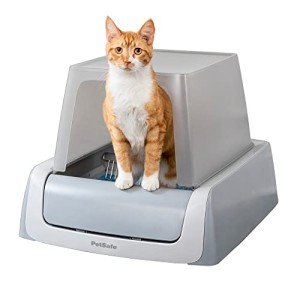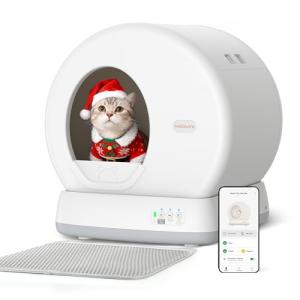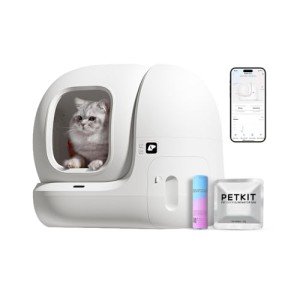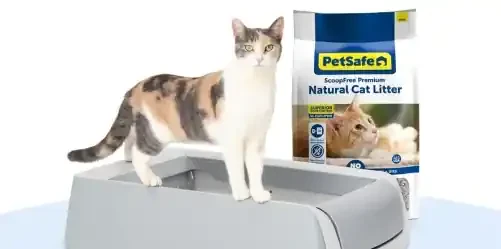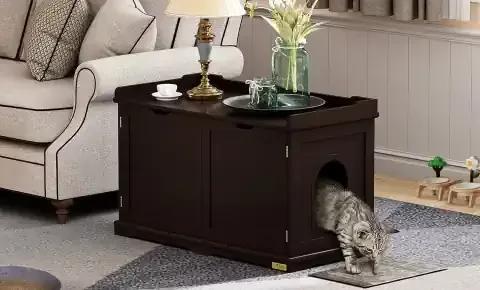Introduction: The Rise of Automatic Litter Boxes
Welcome to the future of feline hygiene! In a world where technology seems to touch every aspect of our lives, it's no surprise that even our furry friends' bathrooms are getting an upgrade. Automatic litter boxes, once a novelty, are now a serious contender in the cat care market, promising convenience and a cleaner home for both cats and their humans.
What Are Automatic Litter Boxes?
Unlike traditional litter boxes that require daily scooping, automatic litter boxes are self-cleaning marvels. These innovative devices use various mechanisms – from rakes and rotating cylinders to sifting systems – to automatically separate waste from clean litter. Some even boast additional features like odor control, app connectivity, and health monitoring.
Why They're Gaining Popularity
The appeal of automatic litter boxes lies in their undeniable convenience. Imagine bidding farewell to the daily chore of scooping smelly litter. For busy professionals, frequent travelers, and anyone who prefers a hands-off approach to litter box maintenance, these devices can be a game-changer. Plus, they often offer superior odor control compared to traditional boxes, contributing to a fresher-smelling home.
Debunking the "Lazy Cat Owner" Myth
While the term "lazy cat owner" is sometimes jokingly associated with automatic litter boxes, it's important to debunk this myth. Owning a cat is a commitment that involves providing care, love, and attention. Automatic litter boxes simply offer a way to streamline one aspect of that care, freeing up time for more meaningful interactions with your feline companion. It's about working smarter, not lazier.
Are They Right For Every Cat and Owner?
As with any product, automatic litter boxes aren't a one-size-fits-all solution. While they offer numerous benefits, they also come with considerations like cost, maintenance, and cat acceptance. In the following sections, we'll delve deeper into the inner workings of these devices, explore their pros and cons, and help you determine if an automatic litter box is the right fit for your furry family.
How Automatic Litter Boxes Work
Prepare to be amazed by the ingenuity behind these high-tech litter boxes. While the concept of a self-cleaning cat bathroom might sound like science fiction, the technology is surprisingly straightforward, relying on a combination of clever mechanisms and smart features to keep your cat's toilet tidy.
Different Types and Mechanisms
Automatic litter boxes come in various designs, each employing a unique approach to waste removal:
Rake Systems: The most common type, these use a rake-like mechanism to scoop clumps of waste into a separate compartment. The rake typically activates after a set timer or when a sensor detects your cat has left the box.
Rotating Cylinders: These models feature a rotating drum that sifts through the litter, depositing waste into a designated container. The cylinder may rotate continuously or on a schedule.
Sifting Systems: Similar to rotating cylinders, sifting models filter the litter through a screen, separating waste from clean granules. Some even use conveyor belts to transport waste to a sealed compartment.
Sensors, Timers, and App Connectivity
Modern automatic litter boxes often incorporate advanced technology to enhance their functionality:
Weight Sensors: Detect your cat's presence and trigger the cleaning cycle only when the box is unoccupied.
Timers: Set cleaning schedules based on your cat's habits or the manufacturer's recommendations.
App Connectivity: Some models allow you to monitor litter box usage, receive notifications when the waste compartment is full, and even adjust settings remotely.
Litter Types and Compatibility
Not all litter is created equal when it comes to automatic litter boxes. Most models are designed to work with clumping clay litter, but some may be compatible with alternative litters like silica gel crystals or biodegradable pellets. It's crucial to check the manufacturer's recommendations to ensure optimal performance and avoid potential malfunctions.
Cleaning and Maintenance Requirements
While automatic litter boxes significantly reduce the frequency of scooping, they still require regular maintenance. This typically involves emptying the waste compartment, refilling the litter, and occasionally cleaning the interior and mechanical components. The specific maintenance requirements vary depending on the model and the type of litter used.
Benefits of Automatic Litter Boxes
Beyond the sheer convenience of not having to scoop litter daily, automatic litter boxes boast a range of advantages that can significantly improve the quality of life for both cats and their owners. Let's delve into the compelling benefits that have propelled these innovative devices into the spotlight.
Odor Control and Hygiene
One of the most significant advantages of automatic litter boxes is their superior odor control. By swiftly removing waste and sealing it in a designated compartment, these devices help minimize unpleasant smells that often emanate from traditional litter boxes. This is particularly beneficial for households with multiple cats or those sensitive to odors. Additionally, automatic cleaning cycles promote a more hygienic environment, reducing the risk of bacterial growth and potential health hazards.
Convenience and Time-Saving
The time-saving aspect of automatic litter boxes cannot be overstated. Imagine reclaiming the minutes you would typically spend scooping and cleaning. For busy individuals, this can be a valuable asset, allowing you to focus on other priorities or simply enjoy more quality time with your feline friend. Plus, automatic litter boxes eliminate the need to handle soiled litter, making the overall cleaning process more efficient and less messy.
Less Litter Tracking
Cats are notorious for tracking litter outside the box, leaving a trail of dusty paw prints throughout your home. Automatic litter boxes, particularly those with covered designs, can significantly reduce this issue. By enclosing the litter and containing waste, these devices help keep your floors cleaner and reduce the spread of litter particles.
Potential Health Benefits for Cats
A clean litter box is essential for your cat's well-being. Cats are naturally fastidious creatures, and a dirty or smelly litter box can deter them from using it. This can lead to urinary tract issues and other health problems. Automatic litter boxes, with their consistent cleaning cycles, provide a more inviting and hygienic environment, potentially promoting healthier bathroom habits and reducing the risk of litter box aversion.
Environmental Considerations
While the environmental impact of automatic litter boxes is a complex issue, some argue that they can be more eco-friendly than traditional boxes. This is primarily due to the reduced frequency of litter changes. Automatic boxes often utilize less litter overall, as waste is promptly removed, preventing contamination of the remaining litter. Additionally, some models are compatible with biodegradable or flushable litter, further minimizing their environmental footprint.
Drawbacks and Considerations
While automatic litter boxes offer a tempting array of benefits, it's essential to consider the potential drawbacks and challenges before making the switch. These innovative devices aren't without their limitations, and understanding them is crucial for making an informed decision that aligns with your cat's needs and your lifestyle.
Initial Cost and Investment
One of the most significant barriers to entry for automatic litter boxes is the upfront cost. These devices can be considerably more expensive than traditional litter boxes, with prices ranging from a few hundred to several hundred dollars. While the long-term savings on litter and reduced vet visits due to potential health benefits can offset the initial investment, it's important to budget accordingly.
Ongoing Maintenance and Supplies
While automatic litter boxes reduce the frequency of scooping, they still require regular maintenance. Emptying the waste compartment, refilling the litter, and cleaning the various components are essential tasks that need to be performed regularly to ensure optimal functionality. Some models may also require specific types of litter or proprietary accessories, adding to the ongoing cost.
Noise Levels
Automatic litter boxes, particularly those with mechanical rakes or rotating cylinders, can be noisy during the cleaning cycle. This can be startling or even frightening for some cats, especially those who are sensitive to sound. While newer models are designed to be quieter, it's important to consider your cat's temperament and noise tolerance before making a purchase.
Potential for Malfunctions
Like any mechanical device, automatic litter boxes can experience malfunctions. Sensors may fail to detect your cat, motors may jam, and software glitches can disrupt the cleaning cycle. While most manufacturers offer warranties and customer support, these issues can be inconvenient and frustrating, especially if they occur frequently.
Cat Acceptance and Adjustment
Not all cats readily embrace the idea of a self-cleaning litter box. Some may be hesitant or even scared of the noise and movement. It's crucial to introduce the automatic litter box gradually and provide positive reinforcement to help your cat adjust. Patience and understanding are key during this transition period.
Top-Rated Automatic Litter Box Models
With a plethora of automatic litter boxes flooding the market, choosing the right one can feel overwhelming. To help you navigate the options, we've curated a selection of top-rated models that consistently garner praise from both experts and cat owners.
Litter-Robot (Pros, Cons, Features)
The Litter-Robot is often hailed as the king of automatic litter boxes, and for good reason. Its iconic globe-shaped design houses a self-cleaning mechanism that uses a rotating drum to sift and separate waste. Key features include:
Pros: Excellent odor control, efficient waste removal, large capacity, app connectivity, and a reputation for durability.
Cons: High price point, bulky size, can be noisy during cleaning cycles.
Features: Self-adjusting cat sensor, customizable cleaning schedules, sleep mode, and a variety of accessories.
PetSafe ScoopFree (Pros, Cons, Features)
If you're seeking a more budget-friendly option, the PetSafe ScoopFree is a popular choice. This model uses a rake system to remove waste and features disposable trays filled with crystal litter. Key features include:
Pros: Affordable, compact design, low maintenance, ideal for crystal litter enthusiasts.
Cons: Limited capacity, requires disposable trays, not compatible with clumping clay litter.
Features: Health counter to track litter box usage, privacy hood option, and a variety of tray styles.
CATLINK Automatic Self Cleaning Cat Litter Box with APP
The CATLINK Automatic Self Cleaning Cat Litter Box with APP stands out for its sleek design and innovative features. This model employs a conveyor belt system to transport waste to a sealed compartment and boasts impressive odor control. Key features include:
Pros: Stylish aesthetics, excellent odor control, self-disinfecting function, app control, and compatibility with various litter types.
Cons: Relatively new to the market, limited user reviews, may require frequent refills due to smaller capacity.
Features: Smart weight sensor, multi-cat recognition, real-time health monitoring, and a self-cleaning cycle that can be activated remotely.
Other Notable Models (Brief Overviews)
Beyond the aforementioned models, several other automatic litter boxes deserve a mention:
CatGenie: A unique self-flushing litter box that uses washable granules instead of traditional litter.
Leo's Loo Too: A stylish and technologically advanced model with smart home integration and UV sterilization.
ChillX AutoEgg: A compact and affordable option with a rotating drum design.
Whisker Litter-Robot 3 Connect: The predecessor to the Litter-Robot 4, offering similar features at a slightly lower price.
Choosing The Right Automatic Litter Box
Selecting the ideal automatic litter box for your feline friend requires careful consideration of various factors. It's not merely about choosing the most expensive or feature-packed model, but rather finding the perfect balance between functionality, your cat's preferences, and your budget.
Factors to Consider
Cat Size and Number of Cats: The size of your cat and the number of cats in your household play a crucial role in determining the appropriate litter box size and capacity. Some models are specifically designed for larger cats or multiple-cat households.
Budget: Automatic litter boxes vary significantly in price. Set a realistic budget and explore models within that range. Remember to factor in ongoing costs like litter and replacement parts.
Features: Do you prioritize odor control? App connectivity? Self-disinfecting capabilities? Consider which features are most important to you and your cat.
Litter Type: If you have a preference for a specific type of litter, ensure the model you choose is compatible.
Noise Level: If you have a noise-sensitive cat, opt for a model known for quiet operation.
Ease of Cleaning: While all automatic litter boxes reduce cleaning frequency, some models are easier to maintain than others. Consider how much time and effort you're willing to invest in cleaning.
Comparing Different Models
A side-by-side comparison of different models can be immensely helpful in narrowing down your options. Consider creating a chart or table that outlines the features, pros, and cons of each model you're considering. This will allow you to visualize the differences and identify which model best aligns with your needs and preferences.
Expert Opinions and User Reviews
Don't underestimate the value of expert opinions and user reviews. Research reputable sources like pet product review websites, consumer magazines, and veterinarian recommendations. Reading firsthand experiences from other cat owners can provide valuable insights into the real-world performance and potential issues of specific models.
Transitioning Your Cat To An Automatic Litter Box
Switching your cat to a new, high-tech litter box may seem like a daunting task, but with patience and the right approach, it can be a smooth and successful transition. After all, you're not just introducing a new gadget; you're changing an essential aspect of your cat's routine.
Gradual Introduction and Positive Reinforcement
The key to a successful transition is to introduce the automatic litter box gradually. Start by placing it next to your cat's existing litter box, allowing them to sniff and explore it at their own pace. Once they seem comfortable with the new box's presence, you can begin phasing out the old one.
Positive reinforcement plays a vital role in this process. Reward your cat with treats, praise, or playtime whenever they use the automatic litter box correctly. This helps create positive associations and encourages them to continue using the new box.
Troubleshooting Tips for Reluctant Cats
If your cat seems hesitant or reluctant to use the automatic litter box, don't despair. Here are a few troubleshooting tips:
Leave the Old Litter in the New Box: Sprinkle some of the used litter from the old box into the new one. The familiar scent can entice your cat to use the automatic litter box.
Adjust the Settings: Some automatic litter boxes allow you to adjust the cleaning cycle's frequency or delay. Experiment with different settings to find one that your cat is most comfortable with.
Try a Different Litter: If your cat seems bothered by the type of litter in the automatic box, try switching to a different brand or variety that they prefer.
Clean the Box More Frequently: If your cat is particularly sensitive to cleanliness, consider manually cleaning the automatic litter box more often than the manufacturer recommends.
Seek Professional Help: If your cat's reluctance persists, consult with your veterinarian or a feline behaviorist. They can offer personalized advice and solutions based on your cat's specific needs and personality.
Ensuring Proper Usage and Safety
Once your cat has successfully transitioned to the automatic litter box, it's important to monitor their usage and ensure their safety. Keep the litter box clean and well-maintained, and always follow the manufacturer's instructions for cleaning and troubleshooting. Additionally, be mindful of any potential hazards, such as loose cords or small parts that could be ingested.
By following these guidelines and exercising patience, you can successfully transition your cat to an automatic litter box, paving the way for a cleaner, more convenient, and healthier litter box experience for both of you.
Addressing Common Concerns and Questions
As automatic litter boxes become more prevalent, cat owners naturally have questions and concerns about their effectiveness, safety, and practicality. In this section, we aim to tackle some of the most frequently asked questions to provide clarity and dispel any doubts.
Is It Worth The Investment?
The value proposition of an automatic litter box depends on your individual circumstances. If you prioritize convenience, odor control, and a cleaner home, the investment can be well worth it. The time saved on scooping and the improved hygiene can significantly enhance your quality of life and your cat's well-being. However, if you're on a tight budget or have a cat who is resistant to change, the high upfront cost and potential adjustment period may not be ideal.
Are Automatic Litter Boxes Safe for Cats?
Safety is a paramount concern for any cat owner. Rest assured that reputable automatic litter box brands prioritize safety in their design and manufacturing. These devices undergo rigorous testing to ensure they are safe for cats of all sizes and temperaments. However, it's crucial to choose a model with safety features like anti-pinch sensors and automatic shut-off mechanisms to prevent accidents. Always supervise your cat during the initial introduction to the automatic litter box and monitor their usage to ensure they are comfortable and using it properly.
What About Multiple Cat Households?
Automatic litter boxes can be a boon for multi-cat households, as they can handle the increased waste volume and reduce the need for multiple litter boxes. However, it's important to choose a model with a large enough capacity to accommodate all your cats' needs. Some models even offer multi-cat recognition features, allowing you to track individual usage and monitor each cat's health.
Do Automatic Litter Boxes Really Work?
The short answer is yes, automatic litter boxes do work. They effectively remove waste, control odors, and provide a cleaner environment for your cat. However, their effectiveness can vary depending on the model, the type of litter used, and your cat's individual habits. It's important to research different models, read reviews, and choose one that aligns with your specific needs and expectations.
Remember, an automatic litter box is not a magical solution that eliminates all litter box-related issues. It still requires regular maintenance and may not be suitable for every cat. However, for many cat owners, the benefits of convenience, hygiene, and a happier feline companion far outweigh the drawbacks.
Conclusion: Are Automatic Litter Boxes a Dream Come True?
As we've journeyed through the world of automatic litter boxes, exploring their mechanics, benefits, drawbacks, and various models, it's time to answer the ultimate question: Are they a dream come true for cat owners? The answer, as you might expect, isn't a simple yes or no. It depends.
Weighing The Pros and Cons
Automatic litter boxes undoubtedly offer enticing advantages, including:
Unmatched convenience: The elimination of daily scooping is a significant draw for busy individuals.
Superior odor control: Many models excel at containing and neutralizing unpleasant smells.
Healthier environment: Cleaner litter boxes can contribute to better feline hygiene and potentially reduce health risks.
Reduced litter tracking: Covered models and efficient waste removal minimize the spread of litter throughout your home.
However, these benefits come at a cost, both financially and in terms of potential challenges:
Initial investment: Automatic litter boxes can be pricey, requiring a significant upfront investment.
Ongoing maintenance: While scooping is eliminated, these devices still require regular cleaning and upkeep.
Cat acceptance: Not all cats readily adapt to automatic litter boxes, and some may require a patient transition period.
Potential malfunctions: Like any mechanical device, these boxes can experience technical issues.
Making an Informed Decision
Ultimately, the decision of whether to invest in an automatic litter box rests on your individual priorities and circumstances. Consider your budget, lifestyle, and the specific needs of your cat(s). If convenience, odor control, and hygiene are top priorities, and you're willing to invest in a quality model and commit to regular maintenance, then an automatic litter box could be a dream come true. However, if cost is a concern or you have a cat who is resistant to change, a traditional litter box may be a more practical choice.
The Future of Feline Litter Box Technology
The evolution of automatic litter boxes is far from over. As technology advances, we can expect even more innovative features, improved functionality, and greater affordability. From smart home integration to advanced health monitoring, the future of feline litter box technology holds exciting possibilities.
As you contemplate whether to embrace this technological leap in cat care, remember that the most important factor is your cat's well-being. Choose a litter box solution – whether automatic or traditional – that prioritizes their comfort, health, and happiness.
Summary
Automatic litter boxes are revolutionizing cat care, offering a convenient and hygienic alternative to traditional litter boxes. These high-tech devices utilize various mechanisms like rakes, rotating cylinders, or sifting systems to automatically remove waste, minimizing odors and reducing the need for manual scooping. While they offer numerous benefits, including convenience, odor control, potential health benefits for cats, and environmental considerations, they also come with drawbacks such as high initial cost, ongoing maintenance requirements, potential noise issues, and the need for cat adjustment.
The market offers a variety of top-rated models like Litter-Robot, PetSafe ScoopFree, and PETKIT Pura Max, each with its unique features and pros and cons. Choosing the right model involves considering factors like cat size, budget, features, litter type, noise level, and ease of cleaning. Transitioning your cat to an automatic litter box requires patience and a gradual approach, with positive reinforcement playing a crucial role.
While automatic litter boxes aren't a perfect solution for every cat and owner, they offer a promising alternative for those seeking to streamline litter box maintenance and provide a cleaner, healthier environment for their feline companions. The future of feline litter box technology holds even more exciting possibilities, with advancements like smart home integration and advanced health monitoring on the horizon. Ultimately, the decision of whether to invest in an automatic litter box depends on individual priorities and circumstances, but for many, the benefits of convenience, hygiene, and a happier cat make it a worthwhile investment.

